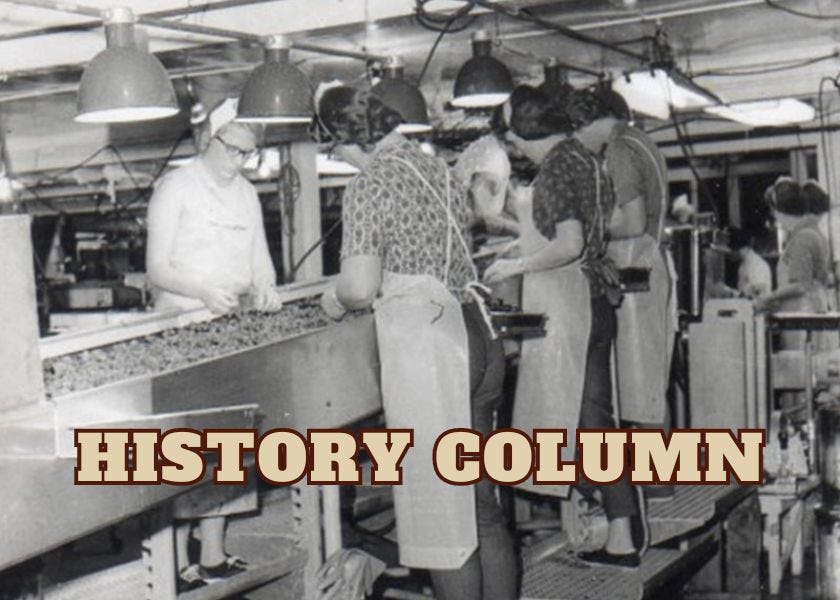There was a time, in the not too distant past, that if you lived in the area and did not work in a cannery, it was likely that you knew one or two people who did. The industry employed hundreds of people year round and thousands of people in round the clock shifts, sometimes operating six and seven days a week during the canning season.
A 1953 Oregon Statesman story reported that there were 18 canneries in the area. They created close to 5 million cases of canned goods that year and used up to 5 million gallons of water each day. If those canneries were combined, they would cover 50 acres of land with half of that covered with the buildings where processing was done. They received fruits and vegetables from 4000 growers in Oregon and Washington.
The first cannery in the area, Salem Canning Co., was opened in 1890 by Robert Wallace. He purchased land and planted an orchard where Salemtowne is now located, and paid for the improvements of the road (named for him) that leads to downtown Salem. He bought land at 12th and Trade Streets from Willamette University in 1887 to establish a fruit evaporator to save some of the fruit from his orchard that would have gone to waste. Wallace made a business arrangement with an experienced cannery man from Iowa in 1890 to come to Salem to build and operate a cannery on the same property.
After years of operation and numerous ownership changes, it was determined that the facility was no longer cost effective. The machinery was dismantled, and in 1953 the property was gifted back to Willamette University.
Robert Paulus, a national leader in the canning industry, was born in the J.K. Gill Building in downtown Salem in 1888. Paulus started in the industry as a bookkeeper for a growers marketing association, the Salem Fruit Union. He became the general manager of the association in 1916. Eight years later, Paulus started his own company headquartered at Trade and High Streets. His brother George joined him, and then Paulus Brothers Packing Company was incorporated in 1927. They were both active in industry organizations. George was elected president of the Northwest Canners Association in 1938 and Robert was elected president of the National Canners Association in 1941.
During World War II, the company provided dried fruits and vegetables for the military. Their efforts were recognized with awards from the War Food Administration. In 1947, they erected a 232,000 square foot building at 14th and Oxford, making it one of the largest canneries in the United States. By 1954 they had made acquisitions of other facilities and were the largest independently operated canning firm in the northwest. The company was sold to the Dole Hawaiian Pineapple Company in 1955.
The 1940’s brought a change to more emphasis on canning green beans and some interesting marketing opportunities with a “Jack and his beanstalk” label.
The Santiam Bean Festival had been an annual event for several years before switching things up in 1949 to crowning a Jack of the Beanstalk and his merry men instead of a bean queen and her court. Eight boys, ages 6 to 8, entered a contest for the position. Eight year old Denny Frank was chosen, he and the other contestants represented the bean festival and the city of Stayton throughout the area. They appeared in parades in Salem, Albany and St. Paul on a float decorated as an oversized bean can. As part of the promotion, Denny Frank, his mother Louise Frank, and festival organizer Gene Malecki, flew to Boston (Beantown). There, Denny presented the mayor’s office with a case of green beans, was interviewed on television, had the chance to visit historic sites and attended a major league baseball game between the Boston Braves and Pittsburgh Pirates.
Another promotional opportunity presented itself in 1952 when a sales broker for Blue Lake Producers saw that the comedy team, Abbot and Costello, were creating a motion picture called Jack and the Beanstalk. He approached the studio about creating a tie-in with the brand. Bud Abbott liked the idea so much that he spent $1000 sending Blue Lake Jack and his Beanstalk beans to 43 radio commentators and journalists. Posters were created for displays in grocery stores and theaters. Cans of green beans with a scene from the movie were used in displays at theaters. Abbot and Costello also made personal appearances where Jack and his Beanstalk beans were featured.
On a personal note, I met my wife, Mary Ann while working at a cannery. We dated while attending college and working at the cannery in the summertime. We have been married since 1982.






